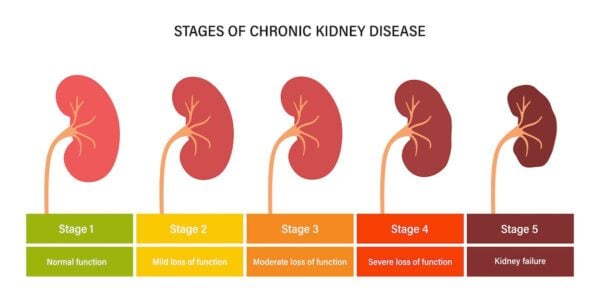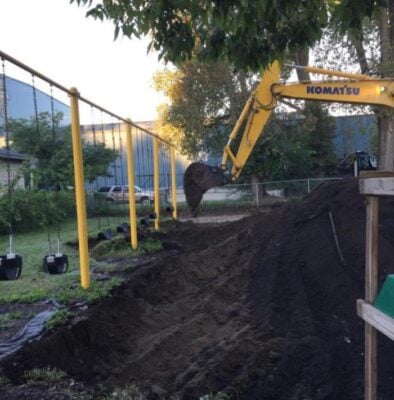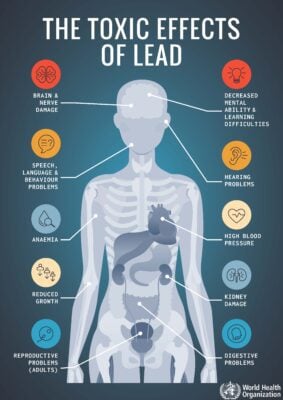Lead is a known toxin, long associated with developmental delays and neurological problems in children, but research shows that its dangers go far beyond childhood learning issues.
Chronic lead exposure can damage the kidneys, leading to long-term health problems that often go unnoticed until they become severe, according to the National Kidney Foundation (NKF).
The Marion County Public Health Department (MCPHD) recently completed a Health Impact Assessment (HIA) for the Martindale Brightwood neighborhood, which includes ZIP codes 46202, 46205 and 46218. The report examined how environmental contamination, including lead exposure, might affect residents’ health.

According to MCPHD data, hospitalization and death rates related to kidney disease have been consistently higher in Martindale Brightwood than in Marion County overall during the past 15 years. Between 2007 and 2021, kidney disease hospitalization rates were elevated across all three five-year periods reviewed. Death rates followed a similar pattern, rising between 2009 and 2018 before slightly decreasing from 2019 to 2023.
“The data shows that residents in this neighborhood face a higher burden of kidney disease compared to the county as a whole,” the report stated, emphasizing that many contributing factors are at play.
How lead affects kidney health
The kidneys act as the body’s filtration system, removing toxins and balancing fluids. According to the NKF, lead builds up in the body over time, settling in bones and tissues. As blood circulates, the kidneys repeatedly filter it, causing gradual damage.
The NKF also reports that lead-related kidney failure is rare, accounting for less than 1% of all kidney failure cases nationwide, but that does not mean the risk is negligible. Even lower levels of lead can cause protein to leak into the urine, elevated blood pressure and gout, which are early signs of kidney stress.

A review published in Renal Effects of Environmental and Occupational Lead reported that past and ongoing exposure can harm kidney function.
The researchers stated, “Lead nephropathy is characterized by chronic interstitial nephritis and progressive renal failure,” meaning long-term damage to the kidney’s filtering structures.
The review found that even at moderate exposure levels, there were measurable increases in creatinine, a waste product used to assess kidney health, and decreases in creatinine clearance, an early indicator of kidney dysfunction.
Kidney damage often goes undetected.
One of the most challenging aspects of lead-related kidney damage is that it develops silently. According to the NKF, people may have no symptoms until significant kidney damage has already occurred.

The NKF explains, “People may not realize their kidneys are being damaged until routine lab tests show signs such as high blood pressure, protein in the urine or abnormal kidney function.”
Local health officials warn that this issue may be severe in neighborhoods like Martindale Brightwood, where environmental exposures, poverty and limited access to health care compound the problem. According to MCPHD, kidney disease rates in the area reflect a complex mix of factors, including lead exposure, lifestyle factors and socioeconomic conditions.
Evidence of harm at low exposure levels
Historically, high-level lead exposure was most common among workers in smelting plants, battery factories and similar industries, according to the review in Renal Effects of Environmental and Occupational Lead. Today, researchers are increasingly concerned about chronic, low-level exposure, especially in urban neighborhoods with older housing and outdated infrastructure.

An extensive cohort study published in the American Journal of Kidney Diseases followed adults for 16 years and found that participants with the highest blood lead levels had a 1.49 times greater risk of developing chronic kidney disease (CKD) than those with lower exposure levels.
According to the researchers, the median blood lead level in this study was only about 25 micrograms per liter, a level far below what was once considered dangerous. This suggests there may be no safe threshold for lead exposure regarding kidney health.
Why Martindale Brightwood is at higher risk
Martindale Brightwood’s elevated kidney disease rates may be tied to its environmental history. According to the Environmental Protection Agency (EPA), the neighborhood includes the former American Lead site, which was designated a Superfund site in the early 2000s due to extensive contamination. The EPA reports that Superfund sites are designated for areas with hazardous waste that poses a significant risk to human health and the environment.

According to MCPHD, many homes were built before 1978, when lead-based paint was still commonly used. As this paint deteriorates, it can create hazardous dust and paint chips. Combined with contaminated soil and potential lead plumbing, residents may face multiple exposure sources over time.
Screening rates in Marion County reveal a gap in detection. According to data from the Indiana Department of Health, only 31% of children under six were tested for lead exposure in 2024. Testing rates in the three ZIP codes covered by the HIA were slightly lower, ranging from 27% to 36%.
These low testing rates mean that many cases of lead exposure may go unnoticed, allowing kidney damage to progress undetected for years.
Prevention and early detection
According to NKF, preventing kidney damage from lead starts with identifying and reducing exposure sources. This includes testing homes for lead hazards, replacing old pipes and addressing contaminated soil.

“Screening and early intervention are critical,” the NKF stated. “By catching kidney problems early, we can slow or even prevent the progression of chronic kidney disease.”
Public health officials emphasize that reducing environmental lead exposure requires a community-wide effort. This includes collaboration between local government, health agencies and residents to replace old infrastructure and improve housing quality.
Addressing lead exposure for families in Martindale Brightwood and across Indianapolis isn’t just about protecting children’s brain development. According to the American Journal of Kidney Diseases, “There may be no threshold below which lead exposure is completely safe.”

Experts say taking action now can help prevent kidney disease and improve community health for generations to come.
MCPHD offers free lead risk assessments, home inspections and blood lead testing through the Marion County Lead Poisoning Prevention Program. Residents can call 317-221-2155 or visit missionunleaded.org to schedule services.
This reporting is made possible by a grant from the Indianapolis African-American Quality of Life Initiative, empowering our community with essential health insights. https://iaaqli.org/
Contact Health & Environmental Reporter Hanna Rauworth at 317-762-7854 or follow her on Instagram at @hanna.rauworth.
Hanna Rauworth is the Health & Environmental Reporter for the Indianapolis Recorder Newspaper, where she covers topics at the intersection of public health, environmental issues, and community impact. With a commitment to storytelling that informs and empowers, she strives to highlight the challenges and solutions shaping the well-being of Indianapolis residents.







Thank you for this Hannah. I live in the 46218 area and I got my pipes tested with Citizens for lead. Came out ok, but I still worry about the ground and overall area. Nobody cares about the Martindale- Brightwood area. To be honest, I don’t think most of the people themselves care, either. I hate it.
Hi Adam,
Yes, lead is an enormous issue, especially for folks in 46218. We try to spread as much information and resources about testing as possible.
Thanks for reading!
Hanna